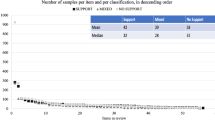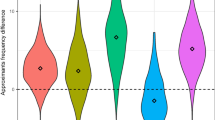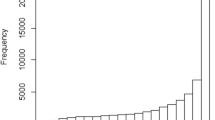Abstract
Research has shown there to be a strong relationship between the mora and prosody in Modern Japanese. Recently proposed, although not as yet independently evaluated, has been a prosodic size rule governing the well-known allomorphic phenomenon of rendaku, by which the initial consonants of non-initial elements in compounds may be voiced under certain conditions. It is claimed that this prosodic size rule flags a native Japanese noun as being rendaku immune, a condition for which no empirical verification has hitherto existed. In this paper the author will demonstrate that, although slight modifications are necessary, a prosodic size rule for flagging rendaku immunity is indeed a reality.
Similar content being viewed by others
References
Alderete, John. 1999. Morphologically governed accent in optimality theory. PhD diss., University of Massachusetts.
Frellesvig Bjarke, John Whitman. (2004) The vowels of proto-Japanese. Japanese Language and Literature 38: 281–299
Fukuda Suzy, Shinji Fukuda. (1999) The operation of rendaku in the Japanese specifically language- impaired: A preliminary investigation. Folia Phoniatrica et Logopaedica 51: 36–54
Fukuzawa, Haruka, and Mafuyu Kitahara. 2001. Domain-relative faithfulness and the OCP: Rendaku revisited. In Issues in Japanese morphology and phonology, ed. Jeroen van de Weijer and Tetsuo Nishihara, 85–109. Berlin and New York: Mouton de Gruyter.
Fukuzawa, Haruka, and Mafuyu Kitahara. 2005. Ranking paradoxes in consonant voicing in Japanese. In Voicing in Japanese, ed. Jeroen van de Weijer, Kensuke Nanjo, and Tetsuo Nishihara, 105–121. Berlin: Mouton de Gruyter.
Fukuzawa, Haruka, Mafuyu Kitahara, and Mitsuhiko Ota. 1998. Lexical stratification and ranking invariance in constraint-based grammars. In Papers from the 34th regional meeting of the Chicago Linguistics Society, Part II: The panels, ed. M. Catherine Gruber, Derrick Higgins, Kenneth Olson, and Tamra Wysocki, 47–62. Chicago: Chicago Linguistic Society.
Gottlieb Nanette. (2005) Language and society in Japan. Cambridge University Press, Cambridge
Hamano Shoko. (1998) The sound-symbolic system of Japanese. CSLI Publications, Stanford
Haraguchi Shosuke. (2001) On rendaku. On’in Kenkyū (4): 9–32
Hirano Takanori. (2000) Phonological structure and sequential voicing: With special attention to the names of rivers. Yamaguchi Daigaku Bungakukaishi 50: 81–85
Irwin Mark. (2005) Rendaku-based lexical hierarchies in Japanese: The behaviour of Sino-Japanese mononoms in hybrid noun compounds. Journal of East Asian Linguistics 14: 121–153
Irwin Mark. (2010) Loanwords in Japanese. Leiden, Brill
Itô, Junko. 1990. Prosodic Minimality in Japanese. In Papers from the 26th regional meeting of the Chicago Linguistics Society Vol. 2: The parasession on the syllable in phonetics and phonology, ed. Michael Ziolkowski, Manuela Noske, and Karen Deaton, 213–239. Chicago: Chicago Linguistics Society.
Itô Junko, Armin Mester. (1986) The phonology of voicing in Japanese: Theoretical consequences for morphological accessibility. Linguistic Inquiry 17: 49–73
Itô, Junko, and Armin Mester. 1995. Japanese phonology. In The handbook of phonological theory, ed. John Goldsmith, 817–838. Cambridge, MA: Blackwell.
Itô, Junko, and Armin Mester. 1999. The phonological lexicon. In The handbook of Japanese linguistics, ed. Natsuko Tsujimura, 62–100. Oxford: Blackwell.
Itô Junko, Armin Mester, Jaye Padgett. (1995) Licensing and underspecification in optimality theory. Linguistic Inquiry 26: 571–613
Itô Junko, Yoshihisa Kitagawa, Armin Mester. (1996) Prosodic faithfulness and correspondence: Evidence from a Japanese argot. Journal of East Asian Linguistics 5: 217–294
Kindaichi Haruhiko. (1976) Rendaku no kai [Explaining rendaku]. Sophia Linguistica 2: 1–22
Kiyose Gisaburō. (1985) Heianchō hagyōshiin-p onron [Evidence that Modern Japanese h-was p-in the Heian Period]. Onsei no Kenkyū 21: 73–87
Kubozono, Haruo. 1999. Mora and syllable. In The handbook of Japanese linguistics, ed. Natsuko Tsujimura, 31–61. Oxford: Blackwell.
Kubozono, Haruo. 2002. The syllable as a unit of prosodic organization in Japanese: Syllable structure, accent and morphology. In The syllable in optimality theory, ed. Caroline Féry and Ruben van de Vijver, 129–156. Cambridge: Cambridge University Press.
Kubozono, Haruo. 2005. Rendaku: Its domain and linguistic conditions. In Voicing in Japanese, ed. Jeroen van de Weijer, Kensuke Nanjo, and Tetsuo Nishihara, 5–20. Berlin: Mouton de Gruyter.
Kubozono, Haruo and Armin Mester. 1995. Foot and accent: New evidence from Japanese compound accentuation. Paper presented at Linguistic Society of America meeting, New Orleans.
Loveday Leo. (1996) Language contact in Japan. Oxford University Press, Oxford
Lyman Benjamin. (1894) Change from surd to sonant in Japanese compounds. Oriental Club of Philadelphia, Philadelphia
Martin, Samuel E. 1952. Morphophonemics of standard colloquial Japanese. Language 28(3, Part 2, Supplement): 1–113.
Martin Samuel E. (1987) The Japanese language through time. Yale University Press, New Haven & London
Matsumura, Akira (eds) (1995) Daijisen. Shōgakukan, Tokyo
Matsumura, Akira (eds) (2002) Daijirin. Sanseidō, Tokyo
McCawley James. (1968) The phonological component of a grammar of Japanese. Mouton, The Hague
Mester Armin. (1990) Patterns of truncation. Linguistic Inquiry 21: 478–485
Motoori, Norinaga. 1822. Kojiki den [Commentary on the ‘Records of ancient matters’]. Edo: Maegawa Rokuzaemon; Osaka: Matsumura Kyūbei; Kyoto: Imai Kihei; Owari: Katano Tōshirō.
Nakagawa Yoshio. (1966) Rendaku, rensei (kashō) no keifu [A genealogy of sequential voicing and sequential non-voicing (working label)]. Kokugokokubun 35: 302–314
Nakagawa Yoshio. (1978) Koyūmeishi no rendaku, rensei no keifu [A genealogy of sequential voicing and sequential non-voicing in proper nouns]. Shizuoka Joshi Daigaku Kenkyū Kiyō 12: 288–302
Numoto, Katsuaki. 2007. Hagyō tenko’on [Labial lenition]. In Nihongogaku kenkyū jiten, ed. Hida Yoshifumi, Endō Yoshihide, Katō Masanobu, Satō Takeyoshi, Hachiya Kiyoto, and Maeda Tomiyoshi, 359–360. Tokyo: Meiji Shoin.
Ogura, Shinpei. 1910. Raiman-shi no rendakuron [Lyman’s rendaku theory]. Kokugakuin Zasshi 16: 9–23, 31–45.
Ohno, Kazutoshi. 2000. The lexical nature of rendaku in Japanese. In Japanese/Korean Linguistics Volume 9, ed. Mineharu Nakayama and Charles J. Quinn, 151–164. Stanford: CSLI Publications.
Okumura Mitsuo. (1952) Jion no rendaku ni tsuite [Rendaku in Sino-Japanese]. Kokugokokubun 21(6): 8–22
Okumura, Mitsuo. 1955. Rendaku. Kokugogaku jiten, ed. Kokugogakkai, 961–962. Tokyo: Tōkyōdō.
Ota Mitsuhiko. (2004) The learnability of the stratified phonological lexicon. Journal of Japanese Linguistics 20: 19–40
Ōtsu, Yukio. 1980. Some aspects of rendaku in Japanese and related problems. In Theoretical issues in Japanese linguistics, ed. Yukio Ōtsu and Ann Farmer, 207–227. Cambridge: MIT Working Papers in Linguistics.
Poser William. (1990) Evidence for foot structure in Japanese. Language 66: 78–105
Rice Keren. (1997) Japanese NC clusters and the redundancy of postnasal voicing. Linguistic Inquiry 28: 541–551
Rosen, Eric Robert. 2001. Phonological processes interacting with the lexicon: Variable and non-regular effects in Japanese phonology. PhD diss. University of British Columbia.
Rosen Eric Robert. (2003) Systematic irregularity in Japanese rendaku: How the grammar mediates patterned lexical exceptions. Canadian Journal of Linguistics / Revue Canadienne de Linguistique 48: 1–37
Rothaug Petra. (1991) . Abriß der japanischen Lautgeschichte [An outline of Japanese historical phonology]. Hamburg, Helmut Buske
Shibatani Masayoshi. (1990) The languages of Japan. Cambridge University Press, Cambridge
Shinmura, Izuru (eds) (2003) Kōjien. Iwanami Shoten, Tokyo
Sugito Miyoko. (1965) Shibata-san to Imada-san: tango no chōkakuteki benbetsu ni tsuite no ichi kōsatsu [Mr Shimada and Mr. Imada: A study of auditory discrimination between words]. Gengo Seikatsu 165: 64–72
Suzuki Yutaka. (2005) Kindai ikō rendaku kenkyū bunken mokuroku (1883–2005) [A catalogue of modern research publications on rendaku]. Bunkyō Gakuin Daigaku Gaikokugo Gakubu Bunkyō Gakuin Tanki Daigaku Kiyō 5: 277–308
Takayama Tomoaki. (1999) Shakuyōgo no rendaku/kōonka ni tsuite [Rendaku and Fortis in loan vocabulary]. Report of the Special Research Project for the Typological Investigation of Languages and Cultures of the East and West 1: 375–385
Takayama, Tomoaki. 2005. A survey of rendaku in loanwords. In Voicing in Japanese, ed. Jeroen van de Weijer, Kensuke Nanjo, and Tetsuo Nishihara, 177–190. Berlin: Mouton de Gruyter.
Tamura Suzuko. (1972) Goseigo ni mirareru onsokōtai [Phoneme alteration in compounds and their derivatives]. Kōza nihongo kyōiku 8: 116–144
Tateishi, Koichi. 1985. One secret language in Japanese: As a special case of reduplication. Ms., University of Massachusetts, Amherst.
Tateishi, Koichi. 1989. Theoretical implications of Japanese musicians’ language. In Proceedings of the Eighth West Coast Conference on Formal Linguistics, ed. Jane Fee and Kathryn Hunt, 384–398. Stanford: CSLI Publications.
Trubetzkoy, Nikolai Sergeyevich. [1939]/1969. Principles of phonology [Grundzüge der Phonologie]. Trans. Christiane Baltaxe. Los Angeles: University of California Press.
Tsujimura Natsuko, Stuart Davis. (1987) The accent of long nominal compounding in Tokyo Japanese. Studies in Language 11: 199–206
Vance, Timothy J. 1979. Nonsense-word experiments in phonology and their application to rendaku in Japanese. PhD diss. University of Chicago.
Vance, Timothy J. 1980a. Comments on Ōtsu (1980). In Theoretical issues in Japanese linguistics, ed. Yukio Ōtsu and Ann Farmer, 229–236. Cambridge: MIT Working Papers in Linguistics.
Vance Timothy J. (1980) The psychological status of a constraint on Japanese consonant alteration. . Linguistics 18: 245–267
Vance Timothy J. (1982) On the origin of voicing alteration in Japanese consonants. Journal of the American Oriental Society 102: 333–341
Vance Timothy J. (1987) An introduction to Japanese phonology. State University of New York Press, Albany
Vance Timothy J. (1996) Sequential voicing in Sino-Japanese. Journal of the Association of Teachers of Japanese 30(1): 22–43
Vance, Timothy J. 2005. Rendaku in inflected words. In Voicing in Japanese, ed. Jeroen van de Weijer, Kensuke Nanjo, and Tetsuo Nishihara, 89–104. Berlin and New York: Mouton de Gruyter.
Vance, Timothy J. 2007. Have we learned anything about rendaku that Lyman didn’t already know? In Current issues in the history and structure of Japanese, ed. Bjarke Frellesvig, Masayoshi Shibatani, and John Charles Smith, 153–170. Tokyo: Kurosio.
Wolfram, Walt, and Natalie Schilling-Estes. 2003. Dialectology and linguistic diffusion. In The hand book of historical linguistics, ed. Brian Joseph and Richard Janda, 713–735. Oxford: Blackwell.
Yamada Yoshio. (1904) Rendakuon no hassei [The genesis of rendaku]. Kokugakuin Zasshi 10: 33–43
Zamma, Hideki. 2005. The correlation between accentuation and rendaku in Japanese surnames: A morphological account. In Voicing in Japanese, ed. Jeroen van de Weijer, Kensuke Nanjo, and Tetsuo Nishihara, 157–176. Berlin and New York: Mouton de Gruyter.
Author information
Authors and Affiliations
Corresponding author
Rights and permissions
About this article
Cite this article
Irwin, M. Prosodic size and rendaku immunity. J East Asian Linguist 18, 179–196 (2009). https://doi.org/10.1007/s10831-009-9044-1
Received:
Accepted:
Published:
Issue Date:
DOI: https://doi.org/10.1007/s10831-009-9044-1




